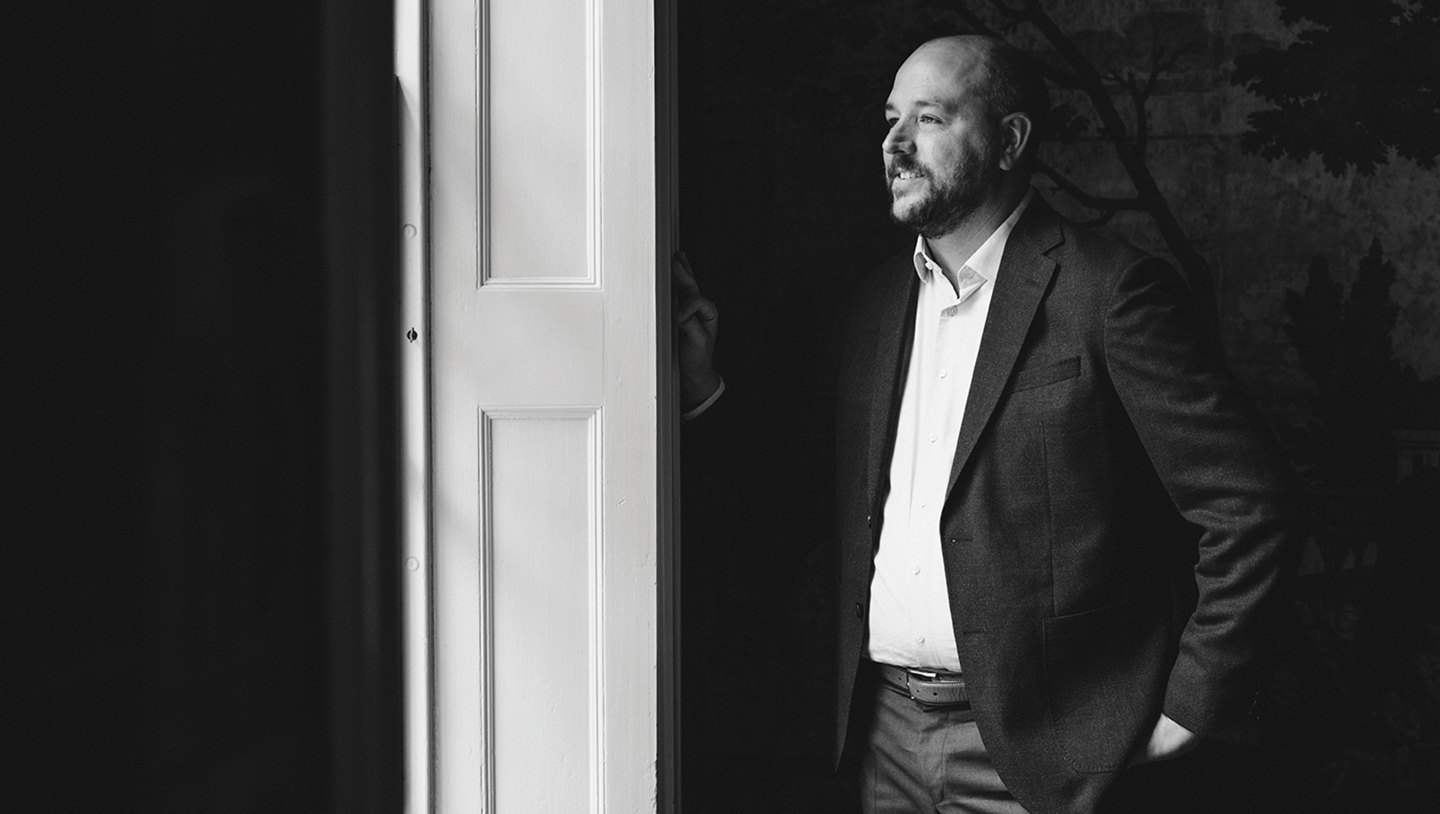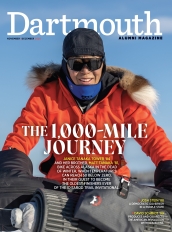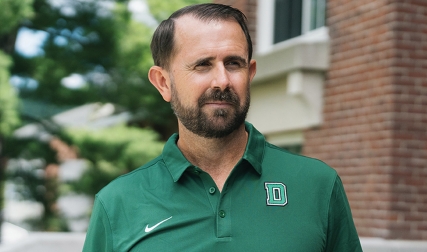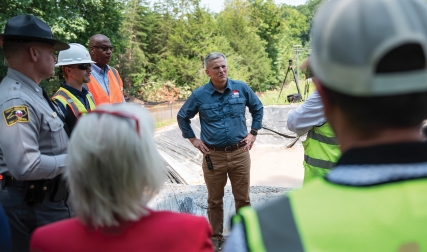Paul Revere’s midnight ride. George Washington crossing the Delaware. The Founding Fathers signing the Declaration of Independence. Many Americans cherish these historic moments of the Revolutionary War. There’s just one problem: They gloss over the ugly parts.
“Wars are really messy,” says David Schmidt. “You’ve got to know that if you’re going to celebrate them.” A historian by training and a documentary filmmaker by trade, Schmidt says the truth about the war that launched this nation will come as a revelation to many Americans. In reality, it was America’s first civil war, pitting countrymen against each other in a bloody conflict that left tens of thousands dead.
Most people don’t think of the Revolution as a civil war, but rather as “Us vs. Them”—the Americans vs. the British. But most people aren’t Schmidt, and most people definitely aren’t legendary documentarian Ken Burns, Schmidt’s boss and codirector (with Sara Botstein) of their latest Florentine Films documentary extravaganza, the six-part series The American Revolution that launches November 16 on PBS stations.
“It was a war between Americans and the British—and a civil war in that they were all British before,” Schmidt continues. “The population living in North America was extremely divided in every community. Ken likes to say that we think of the American Civil War as brother against brother, but it wasn’t in the literal way that the American Revolution actually was brothers fighting brothers.”
Schmidt is explaining Florentine’s approach to portraying America’s birth pains during lunch at an Italian restaurant in the North End of Boston, less than 200 yards from the Old North Church of “One if by land, two if by sea” fame. He’s in town on a sunny mid-April day accompanying Burns, who is receiving the church’s prestigious Third Lantern Award for his decades of work. Later that evening, they will be at Boston’s Symphony Hall for preview clips from The American Revolution and a concert of period music played by Rhiannon Giddens and Johnny Gandelsman, among others. The following day, they head to Lexington, Massachusetts, for the 250th anniversary of the historic battle, the first military engagement of the Revolutionary War.
Even that storied event is more complicated—and was more divisive—than we tend to think, with a unit of Loyalist colonists called “Friends of the King” that came to the aid of British troops. As many as a third of colonists sided with the king and ultimately paid the price in exile, forfeiture, and bitterly estranged families. “We have very different divisions now,” Schmidt says, “but America has always been divided. It’s a misconception, at the very least, to assume that the war of America versus Britain was all of us against all of them. That’s just not true.”
His comments raise some eternally nettling questions. What’s the job of a historian at a time when history itself seems under assault? Whose truth does it tell: the winners’, the leaders’, or everyone else’s? Answering those questions is just another day at the office for Schmidt and his colleagues at Burns’ production company. They hover in the background of the work: years of painstaking, pointillistic research devoted to a telling of history that goes beyond the “Great Man” version to something closer to what actually happened—and why—as told in thousands of individual stories by the men and women who were there.
The hope is that The American Revolution will do for our country’s foundational myths what Burns’ 1990 breakthrough project, The Civil War, did for the “War Between the States”—bring a period written in stone and statuary back to life in all its vibrant, uncomfortable complexity. Only then can we begin to fathom what happened and how that might bear on where we find ourselves now.
It’s a misconception, at the very least, to assume that the war of America versus Britain was all of us against all of them.” —David Schmidt
Schmidt comes by his passion for history by nature and luck of geography, having grown up within Virginia’s “Historic Triangle” of Jamestown, Yorktown, and Williamsburg. “My elementary school shared a wall with the governor’s palace in Colonial Williamsburg,” he says. “We would just walk in there if the teacher didn’t have something else going on.” By age 7, Schmidt was a junior character interpreter at the museum, and starting at age 10, he marched through Colonial Williamsburg twice a week for several years as part of the Fife and Drum Corps. Burns’ The Civil War came out when Schmidt was 3, but he didn’t watch it until he was 8, when his older brother rented the entire series from the local video store.
Of those experiences, he says, “Until Dartmouth, I think it was more of a trivia game. How much can you remember? Then it became: What does history actually mean?” Following two of his five siblings (Andrew ’02 and Lisa ’04), Schmidt arrived in Hanover in the fall of 2005 and went straight to the history department open house. “I remember talking to Colin Calloway. I remember his British accent and asking him, ‘What do you teach?’ He said, ‘Native American history,’ and it blew my mind.”
Calloway says of Schmidt, “What I remember is a serious student who just quietly did his work and routinely got As, which is not routine with me. I still believe you should earn them.” Currently serving in a joint position as a professor of Native American studies and the John Kimball Jr. 1943 professor of history, the Yorkshire-born Calloway was for years head of Dartmouth’s Native American program (now the Native American and Indigenous studies department).
When Schmidt was an undergrad, Calloway taught two survey courses—Native America pre-contact to 1830 and 1830 to the present. “I took both of those and absolutely loved them,” Schmidt says. “He would say, ‘American history doesn’t make any sense without American Indian history,’ and obviously that’s true, but it wasn’t the way I understood American history to that point. I’m really grateful for him opening my eyes about that.” During Calloway’s senior seminar on the Lewis and Clark expedition, students watched and critiqued the Ken Burns documentary on the expedition. Calloway now serves as a talking head in nearly every episode of The American Revolution.
Outside of class, Schmidt spent his years in Hanover playing ultimate Frisbee, hanging out with his brothers in Sig Ep, traveling to London for a foreign study program, leading DOC trips, and playing the fife in the infamous first-year trips’ “safety talk.” (If you know, you know.) He knew Ken Burns often brought his new films to the Hopkins Center and attended a preview screening of Florentine’s documentary The National Parks: America’s Best Idea. He knew the company’s headquarters were nearby in Walpole, New Hampshire. During his senior year, with the 2008 financial crisis casting a pall on job prospects in the postgraduation real world, Schmidt visited the career services offices and saw a posting for a “job shadow” with Florentine Films. “They said, ‘This is usually something that we set sophomores up with. You’re a senior, will you actually go?’ I’m like, ‘Yeah, I’ll definitely go.’ ”

Thanks to Julie Dunfey ’80, a producer at Florentine, Schmidt got in the door as an unpaid intern. He displayed his talent for minutiae his very first day, pointing out a mistake during a rough-cut screening of the baseball documentary, The Tenth Inning. “They were showing the 2001 World Series, the one after 9/11,” he recalls. “That’s a game that was settled in Game 7, where there was one out, but the film said there were two outs. I think other people caught it, too, but I just felt good. Why would Jeter be in that position on the infield if there were two outs?”
Schmidt was eventually hired as an apprentice editor during the early days of work on The Roosevelts: An Intimate History, which came out in 2014. (A Burns project often takes years of research and editing before release.) His Hanover connection proved useful: “I went up to Dartmouth, grabbed the weeklies off the shelf [in Baker Library], scanned them all, and explained what was happening in the political cartoons that you see in the final production of The Roosevelts.” To this day, Schmidt regularly uses the Dartmouth library system for research, accessing databases such as JSTOR, ProQuest, and Readex via remote login.
Moving to Florentine’s New York City offices, Schmidt worked as an associate producer on Burns’ 10-part The Vietnam War documentary (released in 2017), a grueling project not just for the time and effort that went into it but for the brutal combat footage the editors had to comb through.
“Horrible stuff that we had to look at. It completely desensitized me to a degree, but it made me understand what war is,” Schmidt says, acknowledging the effect it had on him when it came time to work on The American Revolution. “I’m grateful there isn’t any gruesome footage from the American Revolution. I’d had enough of that. But we looked for eyewitness accounts that show how violent the Revolution could be. When you hear that a soldier about to have his leg amputated had his other leg taken by a cannonball in the middle of the operation, you don’t have to see it to imagine it. The Revolution was a brutal war that left tremendous loss in its wake, and understanding that only makes it matter more.
“Near the end of Vietnam,” he says, “Ken gave me a call and said, ‘I want to make you a full producer. I want to make movies with you.’ Which was a pretty great phone call to get.” As coproducer of the 2022 Benjamin Franklin, Schmidt read everything he could, found the interview subjects, wrote the interview questions, and more. “Ken decided he wanted Mandy Patinkin to be the voice of Benjamin Franklin, so I had to reach out to him, which was scary but wonderful.”
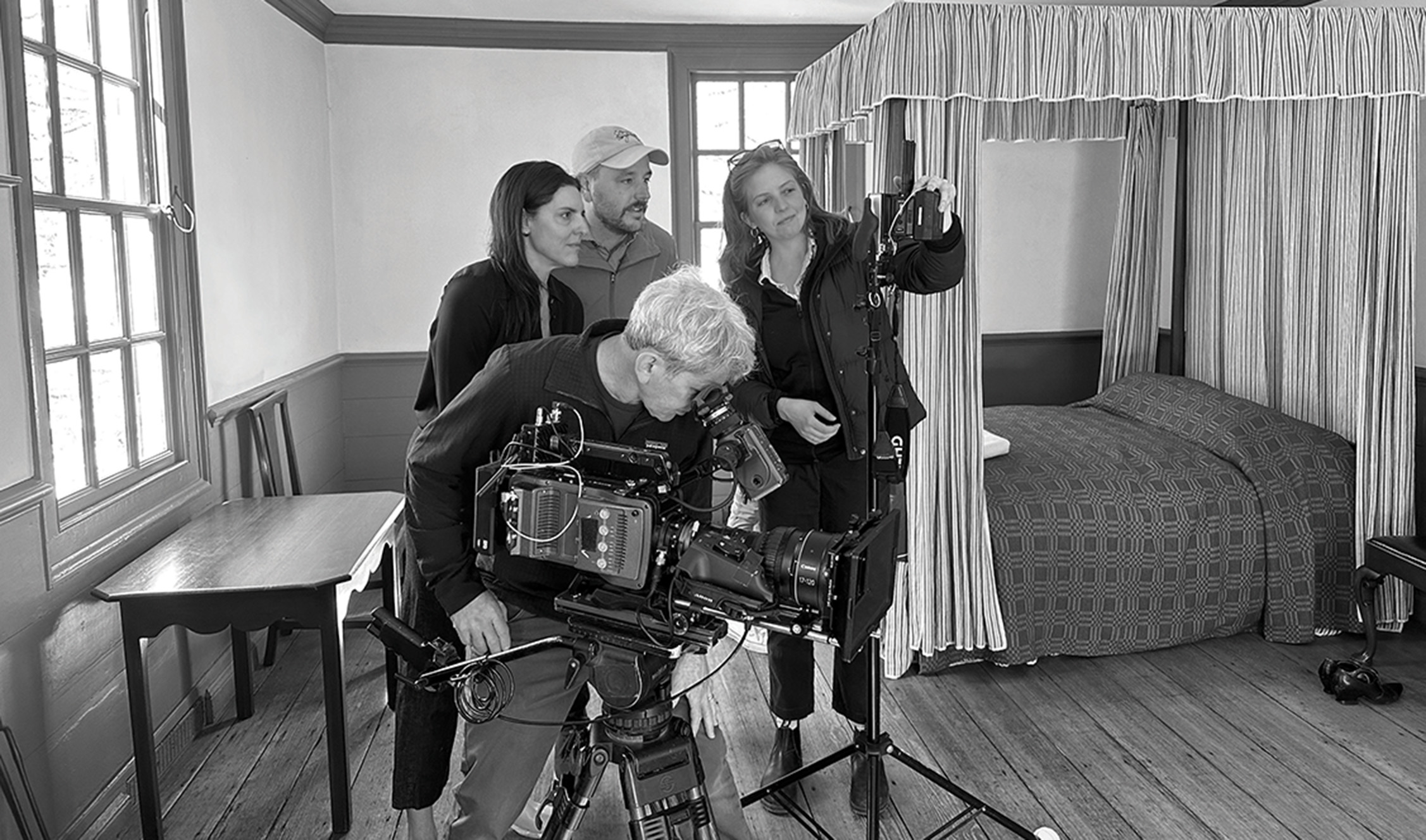
Then came the Revolution project, for which Schmidt was elevated alongside Botstein to a full codirector with Burns. “I can’t think of anybody who’s risen [in the company] as quickly,” says Burns. “I really began to notice David because he took a personal interest in getting it right with the Vietnam series. We said, ‘Well, we need him.’ He’s incredibly smart, really diligent, conscientious, funny. That’s an important thing. This is not brain surgery, so it requires a certain amount of humility.”
In the division of labor on The American Revolution, says Burns, Schmidt was the person who dug out the human stories from the archives. “He’s the history major. He’s rooted in scholarship and research and critical thinking.” Botstein calls Schmidt “a true scholar of voices of the 18th century, [including] ones you’ve never heard of. It’s always the secondary characters that I think infuse a film with humanity. So, while we were looking for a quote from George Washington or Thomas Jefferson or Abigail Adams, he was also helping us figure out the voices of the loyalist John Peters, of Lucy Knox, of Thayendanega, of all the Native voices that are in the film. That’s at the heart of what the show is trying to do—show how the boldface names interacted with the lesser-known people.”
One of the fresh, unheard voices Schmidt unearthed was that of Betsy Ambler, who was a child during the war. “Sarah said, ‘What I think this film could use is the perspective of a child.’ I had read three years before about this girl from Yorktown, Virginia. There were quotes in certain books about women of the Revolution, just little snippets. Her papers are at the Colonial Williamsburg Library, and she was an incredible writer. She was 10 when the war started. She’s now in every episode except for one. She’s the first voice you hear in the third episode and in the sixth episode.”
Schmidt lives in Oregon with his wife—they met at a Dartmouth wedding—and their 3-year-old. Working remotely on Revolution had its challenges: “Covid proved it was possible, and it also proved it’s difficult. But I love my family and I love my job and I get to keep both. So, it’s worth it.”
What seems clear is that The American Revolution is going to tell a richer, more complicated story of the country’s birth than the one most Americans are used to. As the nation heads into 2026 and the 250th anniversary of the Declaration of Independence with a bitterly divided populace and many feeling the entire American experiment is in jeopardy, Burns, Schmidt, and the rest of the Florentine team are ready to assume a protective crouch while remaining sanguine about the simple truth that facts are facts.
A country without a memory is a country of madmen.” —George Santayana, philosopher
Looking ahead to the documentary’s reception by segments of the public that only want to hear the good news, Calloway says many people think “there’s only one Revolution story, and it better be the right one. The timing of it, the teaching of history as a patriotism movement—that is just bad history as far as I’m concerned.”
For Ken Burns, it’s a matter of perspective. “You have to remember,” he says, “we always think the divisions we experience now are the worst ever. The Revolution was horrible—we’re divided and killing each other in suffering proportional to the Civil War in terms of population. We’re divided in the Civil War. We’re divided in 1976 at the bicentennial.” But the responsibility of the filmmaker is to rise above the divisions of the times, Burns explains. “If you try to tell a good story, you separate yourself from those dialectics and do something much more complex. I think the main reaction of most people will be: ‘I had no idea.’ That’s what good history is always about.”
Botstein adds: “We really wanted to get the history right and transcend the cultural moment we’re in so we can make a film that stands the test of time. The occasion of the 250th anniversary of declaring independence from Britain affords us an opportunity to look at how divided we were at our founding, how complicated this country has always been, and how precious and important a democracy is—how essential it is that we participate in it, vote in it, and take good care of it.”
For Schmidt—the boy who played the fife at Colonial Williamsburg and grew up traveling the byways of the past to illuminate the present—it’s simple. “My job is to tell the history and get out of the way. You will draw a different conclusion from me, but you’ll also draw a different conclusion from yourself in time. That is the work we want to do.
“I think the lesson is that these were real people who lived through extraordinary times. If that’s our lot—to be real people living through extraordinary times—maybe there’s something to recognize in them that you see in yourself. I hope our work gives people purchase to stay engaged.”
Ty Burr is a film critic for The Washington Post and author of the movie recommendation newsletter, Ty Burr’s Watch List.
